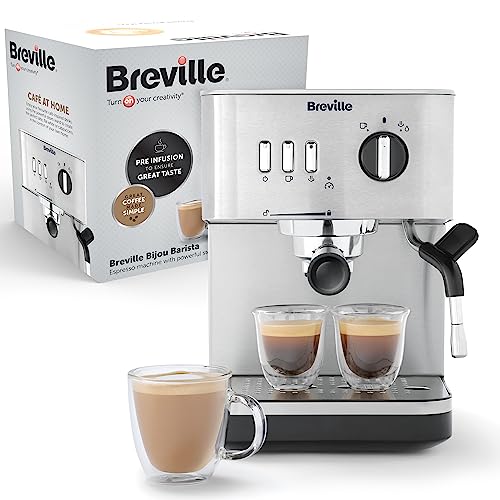How to Use a Coffee and Espresso Maker

A espresso and coffee machine produces shots of water that is highly pressurized. The drinks are forced through finely ground espresso beans that are tightly packed. The result is a drink that's very flavorful, with a dense layer of crema atop.
Certain machines make use of pods or grounds and allow you to control how strong your brew is. others can also steam milk for cappuccinos as well as lattes. There is a stovetop model that works similar to a Moka pot.
1. Buy Guide
The top coffee maker and espresso maker is not just a device for pouring hot water over the grounds. It's also an instrument that can help you create quality drinks at home that are cafe-like. There are numerous options in this area and it can become overwhelming. However there are some factors to consider when choosing the right machine.
Understanding the different brewing methods is the first step. Certain machines rely on gravity to filter water through the grounds, while others brew using pumps. The differences between these methods can influence the final flavor profile as well as cost.
The most sophisticated espresso and coffee makers are usually the most expensive. They might have digital controls or programmable settings. This is why it's important to think about how often you'll be using your coffee-and-espresso maker and whether the extra cost is worth the extra convenience and control.
Semiautomatic models are offered at a lower cost and provide an alternative between manual and automated operation. These devices require some manual work, such as grinding and tapping. However they are more affordable than fully automated models and allow for a more controlled brewing process.
2. Instructions
Utilizing a coffee or espresso maker is easy. The most important part is to select the best ingredients and prepare the machine. It is recommended to use freshly roasted coffee beans, which were ground using an espresso-specific burr mill. espresso. The grinder produces a fine, uniformly-sized powder that ejects the best flavor of the bean. You can also make use of a steam wand blend milk into lattes or cappuccinos.
Before making any drinks you'll need to turn on the espresso maker and allow it to warm up. This can take up to a half hour depending on the size of the machine and is necessary for even heating. The process can be speeded up by pulling a blank which allows you to run the machine with no grounds in the portafilter. This will not just heat the cup however, it will also flush out the group head to prevent a buildup of dirty brew.
Once your machine is ready, pour the coffee grounds into the portafilter. The next step is to tamp the grounds so that you can pack them tightly and evenly. You can purchase an tamper on the internet or at many espresso shops. Once you're done, turn on the machine and place a small cup of water under each spout. To brew the espresso simply turn the control panel to the espresso position. This activates micro-switches which start the heating chamber and pump which pushes the hot water through the ground and out of the spouts.
3. Ingredients
A coffee maker and espresso maker can produce many different drinks. portable espresso machine are among the most versatile brewing tools. This is mainly because they can be used to make espresso-based and drip drinks.
Espresso is a concentrated coffee drink that is produced by pushing hot, high-pressure water through finely roasted beans in a very short time. It's typically sweeter and a little bit thicker than standard coffee. It's an excellent way for you to get more nuanced flavor than drip coffee. However, it's not a good choice for all people.
The best espresso is dark roasted and coarsely ground to maximize flavor extraction. Vigil advises you to "bloom" your coffee prior to making it, which is by pouring hot water over the grounds and letting it sit for 20-30 seconds (releases the flavor notes). After adding the rest of the hot water, you'll use the machine's pressure to push the water through the coffee grounds.
Certain machines are more efficient at this than others, which is why certain espresso makers are known for being a little tricky to use. With a little practice, you can make your own cafe-quality espresso in just a few minutes.
There are other methods to make almost-espresso without a machine, like with siphons (a fancy glass device that utilizes the pressure of vapor to submerge the grounds in hot water). This is a time-consuming and time-consuming process.
4. Preparation
Make sure your espresso machine is plugged in and preheated before you start using it. The water should be at the same temperature throughout your brewing to get as much flavor as you can. It's also an excellent idea to "bloom" the grounds of coffee, or pour a small amount of hot water over them, for around 30 seconds. This will let out any carbon dioxide from the beans and make the taste of your espresso.
When the brew is complete, unplug the portafilter and serve. You can make espresso using an espresso maker, to make single and double shots, or use a steam wand or milk frother to make cafe-style drinks like lattes and capspuccinos. Add some sugar to your espresso for an extra sweet, indulgent drink.
You can also use your espresso maker to make an espresso but you'll need to use a filter as the majority of models don't have the capacity to brew an entire pot. The key to brewing good pot coffee is using freshly made, high-quality beans which are ground to a perfect consistency.
You can also experiment by using different types of water. Hard water has more dissolved minerals, which can cause mineral buildup and less flavorful drinks. Soft or filtered water can cut down on this buildup.
